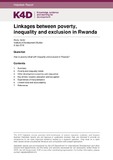| dc.contributor.author | Carter, Becky | |
| dc.coverage.spatial | Rwanda | en |
| dc.date.accessioned | 2018-12-17T16:07:59Z | |
| dc.date.available | 2018-12-17T16:07:59Z | |
| dc.date.issued | 2018-07-09 | |
| dc.identifier.citation | Carter, B. (2018). Poverty, inequality and exclusion in Rwanda. K4D Helpdesk Report. Brighton, UK: Institute of Development Studies | en |
| dc.identifier.uri | https://opendocs.ids.ac.uk/opendocs/handle/20.500.12413/14189 | |
| dc.description.abstract | This review summarises analysis in the literature that provides more detail behind the quantitative data, exploring the nature of inequalities and exclusion in Rwanda, the drivers of these, and how this shapes Rwandans’ vulnerability to poverty. Undertaken in six days, this review draws largely on academic studies as well as reports by international development agencies (most notably the World Bank). Many of the poverty and development studies include some form of gender analysis; there is also work that focuses solely on women and girl’s situations in Rwanda. There are a few studies looking at the linkages between poverty, exclusion and disabilities in Rwanda. Key findings of this review include few studies looking in-depth at the relationship between poverty and inequality in Rwanda, with a lack of disaggregated analyses or detailed case studies (Dawson 2018). Whilst Rwanda has achieved impressive sustained economic growth since the 1990s, poverty in Rwanda is widespread and Rwanda remains the most unequal country in East Africa. Furthermore, The World Bank’s 2015 poverty assessment finds Rwanda’s high inequality driven by location, education and occupation (Bundervoet et al, 2015) whereby there is a deep rural-urban divide, with those most at risk of poverty dependent on agricultural waged labour or smaller/less productive farms, and household heads with no secondary education. The same assessment finds improvements in agricultural productivity and diversification into non-farm activities the main drivers of consumption growth and poverty reduction for 2006-2011. In contrast, other studies highlight how rapid social transformation leads to winners and losers (in absolute or relative terms), and explores the difficulties faced by many in attempting to escape poverty (Verpoorten, 2014: 4; Abbott et al, 2015). Abbott et al (2015: 932) highlight that about a third of the population face a daily struggle for survival, making it difficult to take advantage of opportunities for empowerment. Finally, Rwanda’s path to development remains controversial, with a sharp contrast between the impressive economic progress and standstill in ‘voice and accountability’ (McKay and Verpoorten, 2016). | en |
| dc.language.iso | en | en |
| dc.publisher | IDS | en |
| dc.relation.ispartofseries | K4D Helpdesk Report;359 | |
| dc.rights.uri | https://www.nationalarchives.gov.uk/doc/open-government-licence/version/3/ | en |
| dc.subject | Economic Development | en |
| dc.subject | Education | en |
| dc.subject | Gender | en |
| dc.subject | Health | en |
| dc.subject | Millennium Development Goals | en |
| dc.subject | Population | en |
| dc.subject | Poverty | en |
| dc.subject | Rights | en |
| dc.subject | Rural Development | en |
| dc.subject | Social Protection | en |
| dc.subject | Work and Labour | en |
| dc.title | Linkages Between Poverty, Inequality and Exclusion in Rwanda | en |
| dc.type | Other | en |
| dc.rights.holder | © DFID - Crown copyright 2018. | en |
| dcterms.dateAccepted | 2018-07-09 | |
| rioxxterms.funder | Department for International Development, UK Government | en |
| rioxxterms.identifier.project | K4D | en |
| rioxxterms.version | VoR | en |
| rioxxterms.funder.project | 238a9fa4-fe4a-4380-996b-995f33607ba0 | en |

